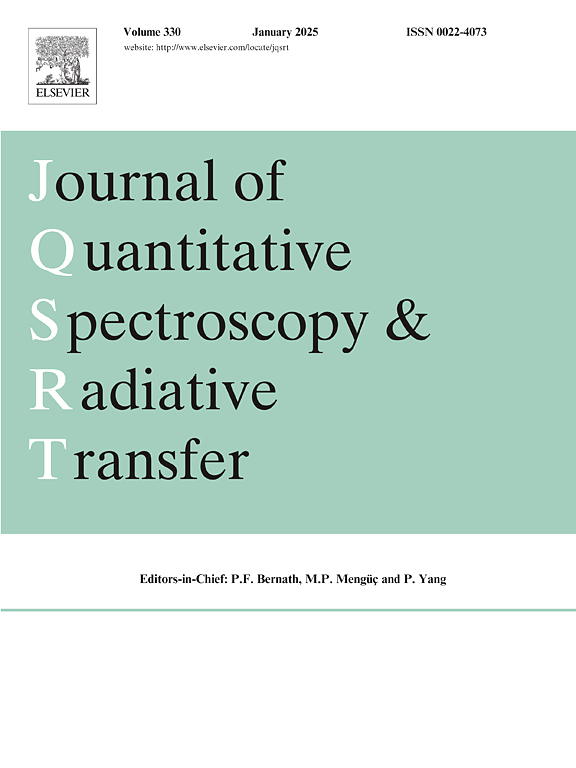Shift of the linear polarization angle of light scattered by anisotropic aerosol and hydrosol particles
IF 1.9
3区 物理与天体物理
Q2 OPTICS
Journal of Quantitative Spectroscopy & Radiative Transfer
Pub Date : 2025-07-18
DOI:10.1016/j.jqsrt.2025.109593
引用次数: 0
Abstract
We simulate single scattering by two types of compositions of scatterers, soot-aerosol-like and organic/mineral-hydrosol-like, with three different overall shapes, ideal amorphous solid spherical aggregates, fractal aggregates, and helices. We expand our recently developed flexible scattering order formulation of the discrete dipole approximation approach to allow birefringent as well as isotropic polarizabilities. Using this formulation for simulating birefringence and the multiple sphere T-matrix (MSTM) model for simulating intrinsic chirality, we contrast the scattering by particles with anisotropic refractive indices, both optically active and birefringent. Then for each polarizability, we calculate the shift of the linear polarization angle (SoLPA) of the scattered light relative to the scattering plane. We investigate the influence of chirality strength, absorption, birefringence strength, and scatterer size on the SoLPA. We find that for single scattering, the SoLPA resulting from intrinsic optical activity is relatively low (), while the SoLPA resulting from birefringence can be relatively large (>1°) or even very large in some cases (>10°). We find that the SoLPA increases approximately linearly with chirality strength, and for low to moderate birefringence strengths, the SoLPA is also increases approximately linearly with birefringence strength. However, for higher birefringence strengths, the linearity of the SoLPA with birefringence strength can break down. We also find that the spatial patterns of the variations in SoLPA as a function of intrinsic chirality strength and birefringence strength tend to be similar for the fractal aggregate and helical scatterers but differ significantly for the ideal amorphous solid aggregate as compared to the other two shapes. This result has implications for any scattering particle whose constituent parts are not arranged on a regular, crystalline-like grid. The SoLPA examined here can become even more significant in multiple scattering environments and thus could have important implications for remote sensing and understanding of polarization sensitive marine species.
各向异性气溶胶和纯溶胶粒子散射光的线偏振角偏移
我们模拟了两种散射体的单次散射,烟灰气溶胶和有机/矿物水溶胶类散射体,三种不同的整体形状,理想无定形固体球形聚集体,分形聚集体和螺旋。我们扩展了我们最近开发的离散偶极子近似方法的柔性散射顺序公式,以允许双折射和各向同性极化。利用该公式模拟双折射和多球t矩阵(MSTM)模型模拟本征手性,我们对比了具有各向异性光学活性和双折射折射率的粒子的散射。然后,对于每个极化率,我们计算了散射光相对于散射平面的线性偏振角(SoLPA)的位移。我们研究了手性强度、吸收强度、双折射强度和散射体尺寸对SoLPA的影响。我们发现,对于单次散射,由固有光学活动引起的SoLPA相对较低(<∼1°),而由双折射引起的SoLPA可能相对较大(>;1°),在某些情况下甚至非常大(>;10°)。我们发现,SoLPA随手性强度近似线性增加,对于低至中等双折射强度,SoLPA也随双折射强度近似线性增加。然而,当双折射强度较高时,具有双折射强度的SoLPA的线性会被破坏。我们还发现,与其他两种形状相比,分形聚集体和螺旋散射体的SoLPA随本征手性强度和双折射强度变化的空间格局趋于相似,而理想的无定形固体聚集体则有显著差异。这一结果对任何组成部分没有排列在规则的晶体状网格上的散射粒子都具有启示意义。这里研究的SoLPA在多重散射环境中可能变得更加重要,因此可能对遥感和了解极化敏感的海洋物种具有重要意义。
本文章由计算机程序翻译,如有差异,请以英文原文为准。
求助全文
约1分钟内获得全文
求助全文
来源期刊
CiteScore
5.30
自引率
21.70%
发文量
273
审稿时长
58 days
期刊介绍:
Papers with the following subject areas are suitable for publication in the Journal of Quantitative Spectroscopy and Radiative Transfer:
- Theoretical and experimental aspects of the spectra of atoms, molecules, ions, and plasmas.
- Spectral lineshape studies including models and computational algorithms.
- Atmospheric spectroscopy.
- Theoretical and experimental aspects of light scattering.
- Application of light scattering in particle characterization and remote sensing.
- Application of light scattering in biological sciences and medicine.
- Radiative transfer in absorbing, emitting, and scattering media.
- Radiative transfer in stochastic media.

 求助内容:
求助内容: 应助结果提醒方式:
应助结果提醒方式:


